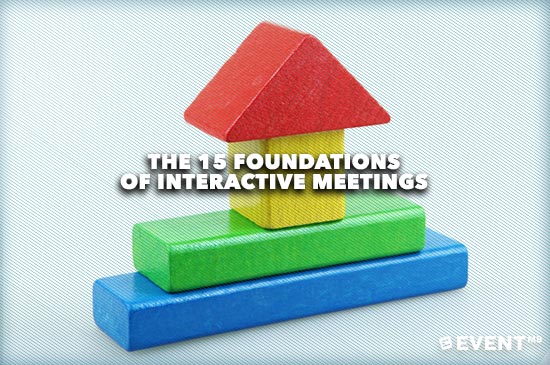Skift Take
Interaction has many faces: interview, panel, debate, brainstorm, workshop, Q&A. They all have different characteristics and give a different added value to meeting design. Here are 15 ways to make your event really interactive.
A real conversation consists of speaking and listening, the exchange of knowledge and information and reaching of a common objective. Many times though, dialogue is no more than a useless exchange of hollow words. The bottom-line is that every shape and form of interaction should follow a few golden rules to make it truly effective.
1. Focus

The objective of any meeting, and of any session within that meeting should be absolutely clear, otherwise any interaction is useless. This may sound obvious, but it needs repeating over and over again. The goal of the conversation should be defined, so that everyone knows, whether it’s about invention, co-creation, prioritising, decision making etc.
2. Concept
To be succesful, a meeting needs a great meeting design. This goes beyond setting a theme and even beyond a creative format for the day as a whole. Effective interaction calls for a seperate design for each part of the programme. A panel for instance, can be executed in a million ways, as can an interview or any other conversation format. Each and every one of the sessions should be designed for the right interaction format.
3. Surprise
Surprise your participants! It will make them learn better and be more cooperative. Dare to be innovative in the session formats, and change format constantly – it will keep your guests fresh.
4. Freedom of Speech
Create guidelines to ensure that any question that has to be asked, will be asked. An environment should be created where everyone feels free to speak his mind. Every opinion counts and is valued. Participants will treat each other with respect, and an open mind. The moderator will be non-judgemental and unbiased.
5. Wholeness
Any aspect of the topic, important to the objective, will be covered. Failing to involve every important aspect in the conversation, will make the result null.
6. Realistic
At the same time, wholeness does not imply that every detail has to be discussed. It is a matter of quintessence and making clear choices.
7. Equality
Participants interact on the basis of equality. If this is not the case (and that may happen, on occasion), this should be communicated and clear to all parties involved.
8. Transparency
It should be clear to all what the purpose of the outcome is and how results will be used.
Facts, opinions, emotions etc are all allowed, but at the same time they are to be labelled clearly.
9. Honesty
Of course the meeting owner is allowed some air-time but please be open about it and don’t try – as we so often see – to cover this up. Participants are not stupid and will know when so called ‘interaction’ is only an excuse for the meeting owner to tell his story.
You can schedule only 5 minutes of Q&A after a 45 minute speech, but please don’t call it interaction.
10. Draw a Line
It is very important to draw a clear line under what is open for discussion and what is not. If a decision has been made and only the execution can be influenced, tell your participants!
11. Be Brave
You can’t completely forecast, what interaction will bring. The meeting owner needs to have the guts to allow real interaction. Within the set boundaries, anything should be allowed to happen.
Interaction will only fly, if you go all the way. Having people listen to 5 speeches, before they actually get involved, doesn’t work. If you truly want to go interactive, your meeting should be interactive every minute of the day, every step of the way.
12. Be Flexible
Change the schedule or even the content, when a detour seems to have added value. If someone from the audience comes up with a great idea or story, cherish it and give it room to grow.
This can all be done, when you have a clear focus on the objective because you’ll know what has added value and what hasn’t.
13. Provide an Alternative
If a participant brings something up, that can’t (or won’t) be addressed within the interaction, give him credit for the contribution, and provide an alternative. After all, his remark may not be important to you, but it sure is to him. You could refer this person to someone else? Or you could promise to look at his problem after the meeting? But be sure to keep your promise!
14. Give the Stage to the Participants

Accept the fact that the meeting is no longer ‘yours’ once you really choose to go interactive. All participants – including you as one of them – define the success of the meeting. Trust in the wisdom of the crowd. And please, do not wait until they start to moan. Actively ask them what their ideas are every step of the way.
15. Involve your Speakers
Your speakers are the first and easiest hurdle towards interaction. Tempt them into changing their ways. Why speak for 40 minutes and have only 5 for Q&A? Why not start with a powerful 10 minute summary, and then open for questions? Or take it one step further even? Start by having the participants do an assignment and use the results to communicate the learning?
Speakers that really know what they’re talking about, have no reason to fear any kind of interaction.
In Conclusion
Going interactive is about having guts. If you hold back, it will be no more than a gimmick and your audience will hate you for it. Participants are not as stupid as many meeting owners think (or hope) and they can tell when you are only pretending to be interactive, instead of really opening up to them.
If you dare to go all the way on the other hand, they will love you and will help you get the maximum result. Involving all people in the room will help you dig into the crowd’s intelligence and you may be surprised with the power available there.
It is all about being interactive: your knowledge and opinions can only grow and prosper if you test them. And just like you, the meeting owner, each and every one of your attendees love to share and cooperate too. Cherish that!





